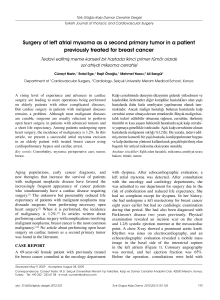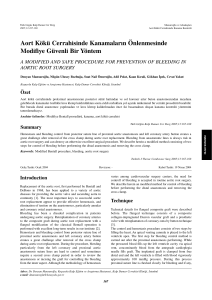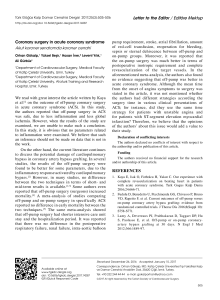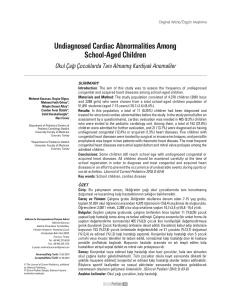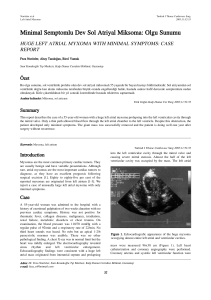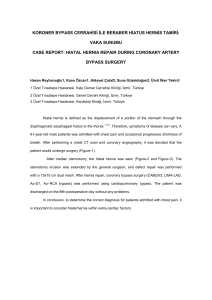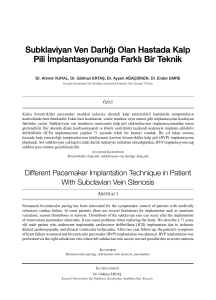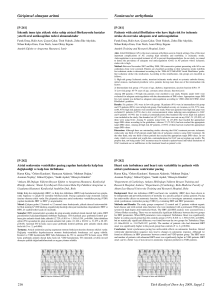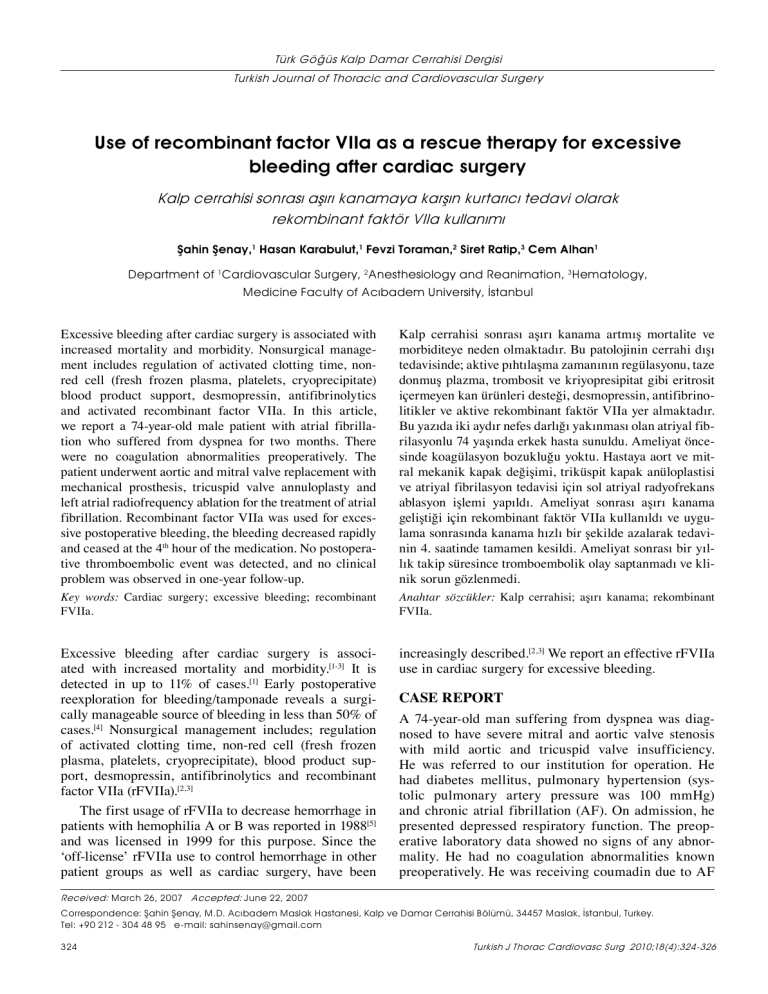
Türk Göğüs Kalp Damar Cerrahisi Dergisi
Turkish Journal of Thoracic and Cardiovascular Surgery
Use of recombinant factor VIIa as a rescue therapy for excessive
bleeding after cardiac surgery
Kalp cerrahisi sonrası aşırı kanamaya karşın kurtarıcı tedavi olarak
rekombinant faktör VIIa kullanımı
Şahin Şenay,1 Hasan Karabulut,1 Fevzi Toraman,2 Siret Ratip,3 Cem Alhan1
Department of 1Cardiovascular Surgery, 2Anesthesiology and Reanimation, 3Hematology,
Medicine Faculty of Acıbadem University, İstanbul
Excessive bleeding after cardiac surgery is associated with
increased mortality and morbidity. Nonsurgical management includes regulation of activated clotting time, nonred cell (fresh frozen plasma, platelets, cryoprecipitate)
blood product support, desmopressin, antifibrinolytics
and activated recombinant factor VIIa. In this article,
we report a 74-year-old male patient with atrial fibrillation who suffered from dyspnea for two months. There
were no coagulation abnormalities preoperatively. The
patient underwent aortic and mitral valve replacement with
mechanical prosthesis, tricuspid valve annuloplasty and
left atrial radiofrequency ablation for the treatment of atrial
fibrillation. Recombinant factor VIIa was used for excessive postoperative bleeding, the bleeding decreased rapidly
and ceased at the 4th hour of the medication. No postoperative thromboembolic event was detected, and no clinical
problem was observed in one-year follow-up.
Kalp cerrahisi sonrası aşırı kanama artmış mortalite ve
morbiditeye neden olmaktadır. Bu patolojinin cerrahi dışı
tedavisinde; aktive pıhtılaşma zamanının regülasyonu, taze
donmuş plazma, trombosit ve kriyopresipitat gibi eritrosit
içermeyen kan ürünleri desteği, desmopressin, antifibrinolitikler ve aktive rekombinant faktör VIIa yer almaktadır.
Bu yazıda iki aydır nefes darlığı yakınması olan atriyal fibrilasyonlu 74 yaşında erkek hasta sunuldu. Ameliyat öncesinde koagülasyon bozukluğu yoktu. Hastaya aort ve mitral mekanik kapak değişimi, triküspit kapak anüloplastisi
ve atriyal fibrilasyon tedavisi için sol atriyal radyofrekans
ablasyon işlemi yapıldı. Ameliyat sonrası aşırı kanama
geliştiği için rekombinant faktör VIIa kullanıldı ve uygulama sonrasında kanama hızlı bir şekilde azalarak tedavinin 4. saatinde tamamen kesildi. Ameliyat sonrası bir yıllık takip süresince tromboembolik olay saptanmadı ve klinik sorun gözlenmedi.
Excessive bleeding after cardiac surgery is associated with increased mortality and morbidity.[1-3] It is
detected in up to 11% of cases.[1] Early postoperative
reexploration for bleeding/tamponade reveals a surgically manageable source of bleeding in less than 50% of
cases.[4] Nonsurgical management includes; regulation
of activated clotting time, non-red cell (fresh frozen
plasma, platelets, cryoprecipitate), blood product support, desmopressin, antifibrinolytics and recombinant
factor VIIa (rFVIIa).[2,3]
The first usage of rFVIIa to decrease hemorrhage in
patients with hemophilia A or B was reported in 1988[5]
and was licensed in 1999 for this purpose. Since the
‘off-license’ rFVIIa use to control hemorrhage in other
patient groups as well as cardiac surgery, have been
increasingly described.[2,3] We report an effective rFVIIa
use in cardiac surgery for excessive bleeding.
Key words: Cardiac surgery; excessive bleeding; recombinant
FVIIa.
Anah­tar söz­cük­ler: Kalp cerrahisi; aşırı kanama; rekombinant
FVIIa.
CASE REPORT
A 74-year-old man suffering from dyspnea was diagnosed to have severe mitral and aortic valve stenosis
with mild aortic and tricuspid valve insufficiency.
He was referred to our institution for operation. He
had diabetes mellitus, pulmonary hypertension (systolic pulmonary artery pressure was 100 mmHg)
and chronic atrial fibrillation (AF). On admission, he
presented depressed respiratory function. The preoperative laboratory data showed no signs of any abnormality. He had no coagulation abnormalities known
preoperatively. He was receiving coumadin due to AF
Received: March 26, 2007 Accepted: June 22, 2007
Correspondence: Şahin Şenay, M.D. Acıbadem Maslak Hastanesi, Kalp ve Damar Cerrahisi Bölümü, 34457 Maslak, İstanbul, Turkey.
Tel: +90 212 - 304 48 95 e-mail: [email protected]
324
Turkish J Thorac Cardiovasc Surg 2010;18(4):324-326
Şenay ve ark. Kalp cerrahisi sonrası aşırı kanamaya karşın kurtarıcı tedavi olarak rekombinant faktör VIIa kullanımı
and it was stopped five days before the surgery. The
patient underwent aortic and mitral valve replacement
with mechanical prosthesis, tricuspid valve annuloplasty and left atrial radio frequency ablation for the
treatment of AF. The operation was uneventful. The
patient was transferred to the ward on the 1st postoperative day. On the 3rd postoperative day he suffered from
a dyspnea, the oxygen saturation was 97-100% but the
teleradiogram revealed a mediastinal enlargement.
Emergent echocardiographic examination revealed
pericardial effusion of 1 cm totally encircling the heart
with no signs of tamponade. Respiratory insufficiency
developed, the patient was transferred to the intensive
care unit and reintubated. He immediately underwent
reoperation with cardiopulmonary bypass due to acute
circulatory collapse, the pericardial collection was
determined and removed. An intraaortic balloon pump
was inserted. The chest was left open due to excessive
bleeding. He received blood products to compensate
for blood loss. A coagulation disturbance was determined. Despite reversal of heparin with protamine and
administration of blood products, this diffuse bleeding
continued. The patient received, in total, six units of
packed red blood cells, 11 units of fresh-frozen plasma,
eight units of fresh blood, four units of platelet concentrates and aprotinine. However, no signs of reduction
of the diffuse bleeding of more than 200 ml per hour
could be obtained. Despite acceptable coagulation
parameters found in the routine laboratory investigation, no clot formation was present in the wound and
severe diffuse bleeding persisted for the next 12 hours
(Fig. 1). Therefore, we decided to administer rFVIIa
(Novo-Seven; Novo Nordisk, Mainz, Germany). It was
given intravenously as a bolus (100 µg/kg body weight)
in two doses, and the bleeding decreased immediately
400
Blood loss (ml)
DISCUSSION
The main usage of rFVIIa in cardiac surgery has been
reported as prophylactic, in patients with preoperative
coagulation disturbances and as a “rescue” therapy in
excessive bleeding refractory to other treatments.[3] The
mechanism of action involves generation of thrombin by
initial binding of rFVIIa to tissue factor and subsequent
activation of factor X on the platelet surface; activated
factor X in combination with factor V leads to localized
thrombin formation. This occurs in the absence of factor
VIII or factor IX, which is most probably the situation
that we will face after cardiopulmonary bypass. The
extent of thrombin activation relates to the concentration
of activated factor VII applied.[2,3] The optimal timing of
administration and dose of rFVIIa for cardiac surgery
is unclear. Significant reduction in blood loss has been
reported with single or two doses of 20 to 100µg/kg.[2,3]
The main adverse outcome is the thromboembolic complication in patients treated with rFVIIa. It is reported in
5-6% of the patients.[3,6]
In this present case we administered rFVIIa due to
uncontrollable and life threatening bleeding after cardiac surgery. Hemostasis was achieved following two
doses of 100 ug/kg of rFVIIa, within the first two hours.
There was no thromboembolic event. Excessive bleeding
requiring massive transfusion possibly led to excessive
fibrinolysis and dilutional coagulopathy, which might
have further exacerbated bleeding in our case. FVIIa
administration was effective to cease such pathology.
As a conclusion rFVIIa can play a beneficial role
as an adjunctive hemostatic agent in patients after
cardiac surgery with excessive bleeding that cannot be
controlled by conventional therapies. The prophylactic
use, safety, optimal patient selection, dose and timing of
rFVIIa administration needs to be assessed with more
prospective studies.
300
200
100
0
to 50 mL/h during the next few hours and some clot
formation occurred. The bleeding decreased to 50
mL/4h and then dropped below. Chest closure was performed and the patient was transferred to the intensive
care unit. During the next day, the bleeding remained
below 50 mL/24h and then ceased. No postoperative
thromboembolic event was detected, and no clinical
problem was observed in one-year follow-up.
Declaration of conflicting interests
The authors declared no conflicts of interest with respect
to the authorship and/or publication of this article.
0
1
4
7 10 13 16 19 22 25 28 31 34 37 40 43 46
Evaluation time (h)
Fig. 1. The blood loss after the reexploration. Note the dramatic
cessation of bleeding after the administration of factor VIIa.
Türk Göğüs Kalp Damar Cer Derg 2010;18(4):324-326
Funding
The authors received no financial support for the
research and/or authorship of this article.
325
Şenay et al. Use of recombinant factor VIIa as a rescue therapy for excessive bleeding after cardiac surgery
REFERENCES
1. Nuttall GA, Oliver WC, Santrach PJ, Bryant S, Dearani JA,
Schaff HV, et al. Efficacy of a simple intraoperative transfusion algorithm for nonerythrocyte component utilization after
cardiopulmonary bypass. Anesthesiology 2001;94:773-81.
2. Levi M, Peters M, Büller HR. Efficacy and safety of recombinant factor VIIa for treatment of severe bleeding: a systematic review. Crit Care Med 2005;33:883-90.
3. Warren O, Mandal K, Hadjianastassiou V, Knowlton L,
Panesar S, John K, et al. Recombinant activated factor VII in
cardiac surgery: a systematic review. Ann Thorac Surg 2007;
326
83:707-14.
4. Moulton MJ, Creswell LL, Mackey ME, Cox JL, Rosenbloom
M. Reexploration for bleeding is a risk factor for adverse outcomes after cardiac operations. J Thorac Cardiovasc Surg
1996;111:1037-46.
5. Hedner U, Glazer S, Pingel K, Alberts KA, Blombäck M,
Schulman S, et al. Successful use of recombinant factor VIIa
in patient with severe haemophilia A during synovectomy.
Lancet 1988;2:1193.
6. O’Connell KA, Wood JJ, Wise RP, Lozier JN, Braun MM.
Thromboembolic adverse events after use of recombinant
human coagulation factor VIIa. JAMA 2006;295:293-8.
Turkish J Thorac Cardiovasc Surg 2010;18(4):324-326

